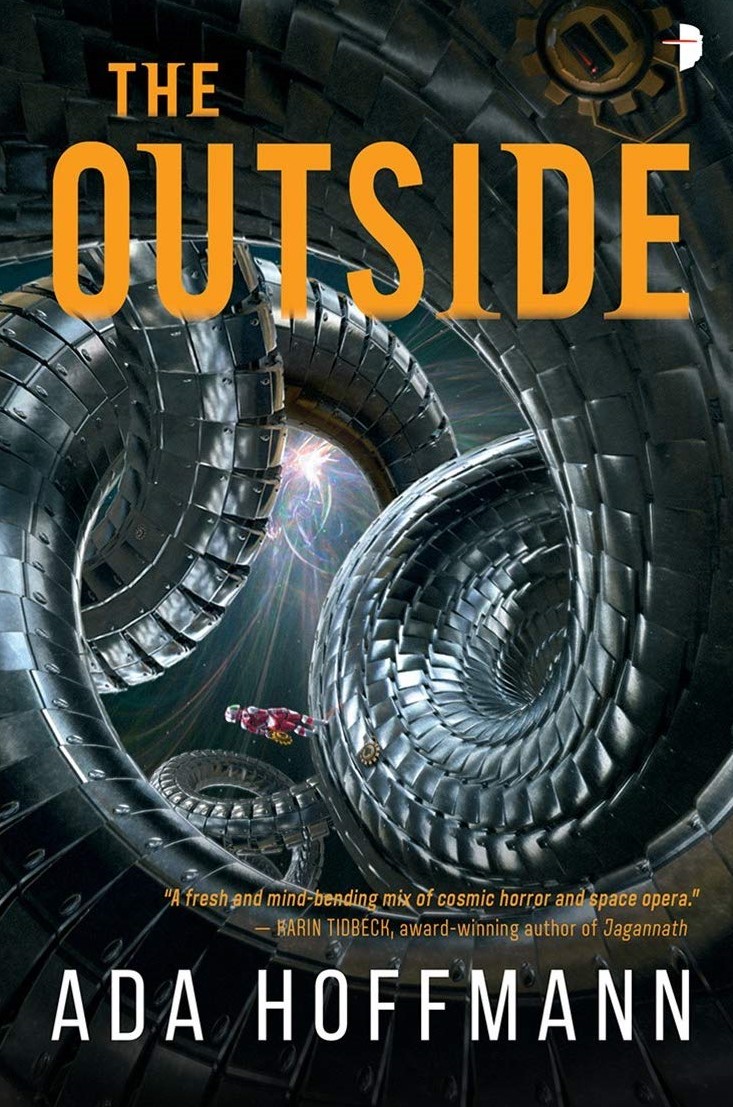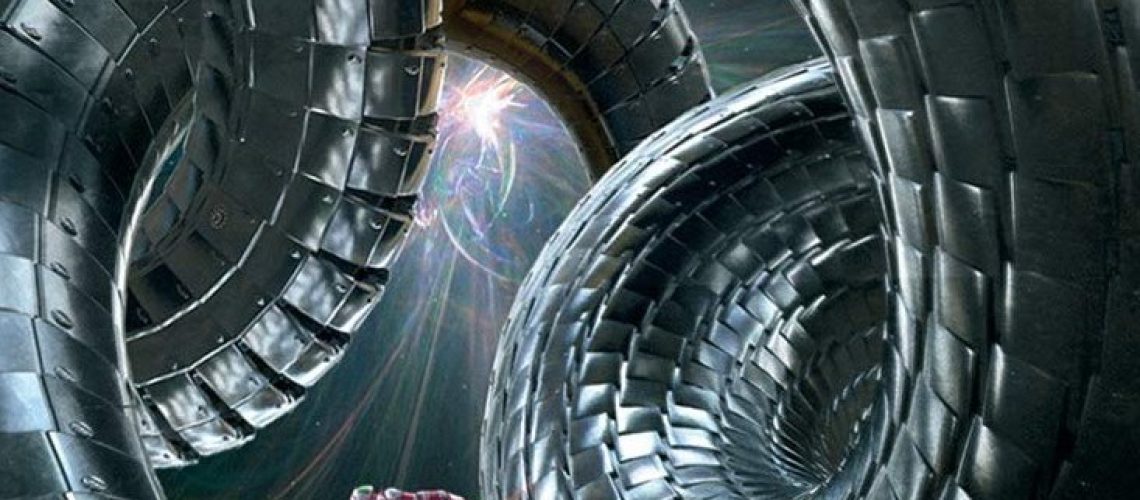With a boffo combination of hard science fiction, cosmic Lovecraftian horror, both cyber- and god-punk, some ridiculously charismatic aliens, and a fascinating female protagonist somewhere on the autism spectrum, Ada Hoffman’s The Outside feels like it was made to order for us here at Skiffy and Fanty!
But this isn’t just another space adventure, and its protagonist’s uniqueness, however refreshing, is not the most interesting thing about it. The Outside is a work of near-maddening subtlety that plays with an interesting set of conundra: given that we perceive the universe via kluged-together sense organs with very limited range, how much of what is actually Outside can we comprehend? Say we try to do something about it and invent machines to augment our senses. And then we let them evolve into godlike self-aware entities. The better to expand our horizons?
However, given that we, the creators of these godlike entities, can only give them better versions of what senses we thought to give them, are these entities going to be any better at perceiving what we cannot? And tasked with shepherding our poor hapless klugiform biotes, how would they interpret what they perceived if they could? What if, like their creators, they instinctively interpreted the Unknown as Hostile?
Such is the case in the universe of The Outside, with the added twist that certain neuro-atypical humans seem to have a natural affinity to the things and forces that exist beyond our ordinary senses — an affinity that manifests when they are too young to understand that they’re different in more ways than early childhood screenings can identify.
If such people were among us now, it’s highly likely that they would at best be considered slightly wackadoo and only taken seriously by the likes of Linda Moulton Howe or Kerry Cassidy or George Noory. At worst, they’d probably be institutionalized or dead.

In The Outside, Humanity has colonized the galaxy, but it hasn’t done it alone: our first step to the stars involved creating a dozen or so artificial intelligences so vastly powerful that they’ve come to be regarded as gods. These gods are served by a hierarchy of cybernetically-enhanced human “angels” who help them run the teeming variety of human-inhabited planets — and guard against heresy, both of the ordinary disbelief or unorthodox doctrinal kind and of a much bigger, boundary pushing kind.
Like contact with the Outside.
So of course our heroine is going to be a heretic, though not the worst one. Dr. Yasira Shien is a scientist-engineer, the finest student of a famous physicist who disappeared after the pair laid most of the groundwork for a new kind of reactor set to power the first completely human-designed and -run space station. All under the watchful attention of the gods and angels, of course, because building stuff without the gods’ help is generally verboten. But every once in a while, they like to watch people try, I guess.
Before we know it, disaster strikes on the station. In the chaotic and tragic aftermath, Yasira is torn from the small island of comfort she’s created for herself. That includes an adorable girlfriend named Productivity — Tiv for short — from a culture given to sermonizing via children’s names like the Puritans of early New England. Fearing she’ll never see Tiv or her family again, and haunted by a hundred deaths from her reactor’s mysterious failure, Yasira is whisked away by a stern batch of angels to go find her erstwhile mentor, Dr. Evianna Talirr, whose dimension-bending heresies may be a threat to Reality Itself™.
There’s a bit of a slow burn after the initial build to disaster and the breathless escape of the novel’s opening, but the patient reader is rewarded with a thoughtful exploration of this culture’s strict orthodoxy and the dangers it holds at bay. Our heroine is soon caught between loyalties, and even we readers, who share the omniscient third person narrator’s intimate knowledge of Yasira’s experience, are kept guessing which one is the true one. After all, time and space themselves are lies, according to Dr. Talirr, whose every move serves to prove that very point.
Dr. Talirr is another utterly fascinating character. She is another autist* whom the gods and angels have studied — and experimented on — since birth because she is Heresy Personified™, obviously more in touch with the Outside than with, say, her family. An interesting question poses itself as her back-story unfolds via her observers’ lab notes: would she still have become the Arch Heretic if she had just been left alone?
We also follow one Akavi, a heavily augmented shapeshifting angel tasked with fixing what Yasira and Dr. Talirr have broken. He (sometimes she, because shapeshifter) serves as the stand in for the status quo, the Powers That Be™. Determining whether or not that is a good thing is a question the novel manages to make wonderfully complicated.
I make this sound more like a philosophical thought experiment than a novel. Indeed, at times, this book broke my brain in a way that hasn’t happened since I tackled Greg Egan’s The Clockwork Rocket. But there is fun to be had, too. For instance, the novel brims with small touches that bring the world-building almost to the level of art, like a hastily programmed alien-to-human translator that was cobbled together in haste by the angels and only recently upgraded and expanded by an alien linguist from yet another species. The output of the resulting contraption is as amusing as the alien linguist’s arch remarks about how bad the system was originally. Oh, and get ready for that linguist, a vaguely spider-form being named Sispirinthis, who steals every scene it’s in but isn’t in enough scenes. I would gladly read a Sisipirinthis side-quel, you guys. Gladly.
But this is Yasira’s book, and it is deeply concerned with depicting her neurotype’s reactions to decidedly odd and nearly indescribable situations — as well as to ordinary social ones. Presented on an even plane, the violations of the laws of physics and contacts with the unfathomable presences of the somewhat Lovecraftian Outside seem equally challenging to the neurotypical reader as dealing with crazy crowds of strangers and correctly interpreting the emotional expressions of close friends are for Yasira and Talirr — which is doubtless the point.
Interestingly, though, there’s a divergence in Yasira’s and Talirr’s experiences that may be generational or may be due to The Outside’s uncanny affinity for Talirr. Whichever interpretation is “correct” (Hoffman leaves it engagingly ambiguous), it makes Talirr an ideal mentor for Yasira, if a uniquely demanding one.
Allistic myself, I saw in their back stories and in Yasira’s presence a glimpse of a future that promises a much better life experience for autists, with very precise and early diagnoses and typing, childhood education tailored to their learning style and organically incorporated advanced coping strategies. Most importantly, a future society where a much greater understanding and acceptance of their differences is the rule rather than the exception.
I’m going to be very interested to see how autistic SF fans respond to this aspect of the book.
For me, I enjoyed the roller coaster ride that is the plot, the feast of challenging ideas, and the fascinating characters. I also relished the mystery of the Outside, which could easily have become just another alternate space teeming with monsters but here balances on the more abstract and cerebral side even as it entertainingly warps reality.
While the novel is complete in its own right, the ending, while perfectly satisfying, has left several groupings of characters in interesting places and with new conflicts looming. As such, I suspect this is a “Book One.” I look forward to another.
The Outside is quite possibly the best book I’ve read so far this year. Mad respect, Ms. Hoffman!
*This was my first encounter with this short and graceful person-centered term for a person with autism. I like it, in part because it’s accidental cognate to “artist.”
The Outside by Ada Hoffman will be released on June 4, 2019 by Angry Robot Books. It will be available where all good books are sold.







